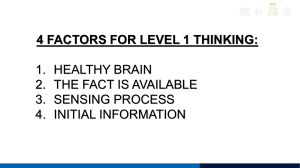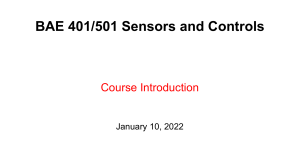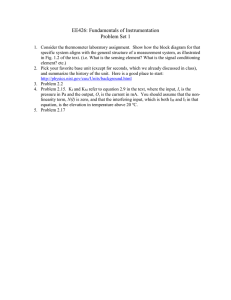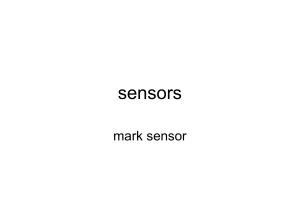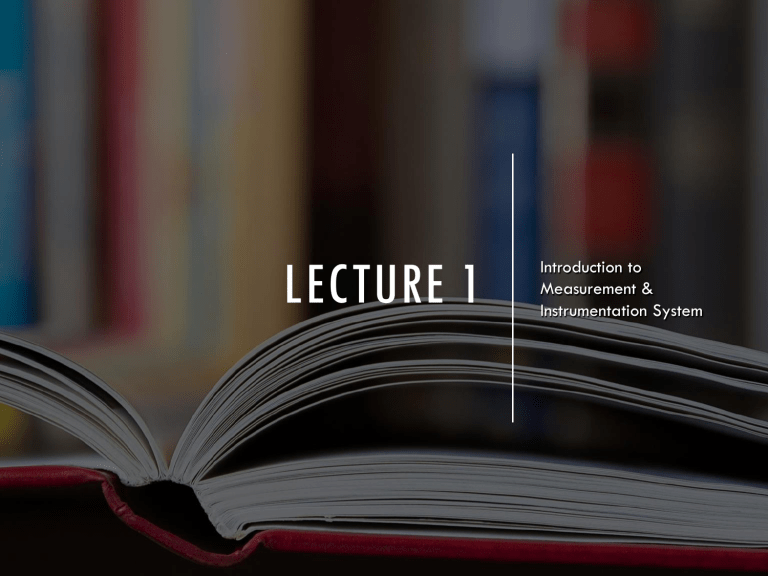
LECTURE 1 Introduction to Measurement & Instrumentation System LESSON OUTCOME AT THE END OF THE LESSON, STUDENT SHOULD BE ABLE TO: 1. Explain the application/purpose of measurement system. 2. Elaborate, discuss and explain the structure of measurement system in term of: i. ii. Basic functional elements Auxiliary functional elements 2 INTRODUCTION Body temperature Body weight Measurement in everyday life Temperature Distance travel Strain Measurement in mechanical engineering Pressure Vibration Room temperature 3 WHY DO MEASUREMENT? TO DETERMINE VALUE OF VARIABLE TO UNDERSTAND HOW VARIABLES CHANGE WITH TIME & LOCATION 4 is an act of assigning a specific value to a physical variable WHAT IS MEASUREMENT? is a tool used that provide quantitative information on the actual state of physical variables and processes. 5 •Control of certain process or operations •Simulation of system conditions •Experimental design studies •Testing of materials, maintenance of standards and specifications of products •Verification of physical phenomena/scientific theories APPLICATIONS OF MEASUREMENT SYSTEM •Quality control in industry 6 Basic functional element STRUCTURE OF MEASUREMENT SYSTEM • Sensing element (sensor element) • Signal conditioning element • Signal processing element • Data presentation element Auxiliary functional element • • • • Calibration element External power element Feedback element Microprocessor element 7 STRUCTURE OF MEASUREMENT SYSTEM Input True value of variable Input True value Sensing Element Transmission path Signal Conditioning Element Measurement system Output user Measured value of variable Signal Processing Element Data Presentation Element Output Measured value Data Acquisition System (DAQ) 8 9 SENSING ELEMENT (SENSOR) A sensor is a device that measures physical input from its environment and converts it into data that can be interpreted by either a human or a machine. Sensors with a mechanical output are commonly used as the primary sensing element in measurement systems for mechanical variables. E.g.: Force and flow rate Most sensors are electronic (the data is converted into electronic data), but some are simpler, such as a glass thermometer, which presents visual data Sensors convert physical parameters to electrical signals. In order to obtain an electrical signal, this primary element is followed by a secondary sensing element with an electrical output signal 10 SENSING ELEMENT (SENSOR) In contact/contactless with the monitored structure, detect or sense the measurand. Gives an output which depends on the variable to be measured. Example: Thermocouple – milivolt depends on temperature A flow meter is a device that measure the amount of liquid, gas, or vapor moving through a pipe (m3/s) strain gauge – resistance depends on mechanical strain 11 DESIRABLE CHARACTERISTIC OF TRANSDUCER ELEMENT It should recognize and sense the desired input signals present simultaneously in the measurand. E.g. a speed sensor should sense the instantaneous velocity and should be insensitive to the local pressure or temperature It should not alter the event to be measured The output should preferably be electrical to obtain the advantages of modern computing and display devices It should have good accuracy 12 DESIRABLE CHARACTERISTIC OF TRANSDUCER ELEMENT It should have good reproducibility (i.e. precision) It should have amplitude linearity It should have adequate frequency response (i.e. good dynamic response) It should not induce phase distortions (i.e. should not induce time lag between the input and output transducer signal) It should be able to withstand hostile environments without damage and should maintain the accuracy within acceptable limit 13 It should have high signal level and low impedance DESIRABLE CHARACTERISTIC OF TRANSDUCER ELEMENT It should be easily available, reasonably priced and compact in shape and size (preferably portable) It should have good reliability and ruggedness. In other words, if a transducer gets dropped by chance, it should still be operative Leads of the transducer should be sturdy and not easily pulled off 14 SIGNAL CONDITIONING ELEMENT Definition How it works Signal conditioning is the technique of making a signal from a sensor suitable for processing by data acquisition equipment. Takes the output of the sensing element and converts it into a form more suitable for further processing, usually in the form of a DC voltage, current, variable frequency AC voltage. 15 16 SIGNAL CONDITIONING ELEMENT Example of problems How to solve The output of the sensing element is usually too small to operate an indicator or a recorder. Therefore, it is suitably processed and modified in the signal conditioning element so as to obtain the output in the desired form. • Using amplifier-increasing the amplitude of the signal without affecting it waveform. 17 SIGNAL CONDITIONING ELEMENT Example of problems How to solve Signal attenuation is reducing the amplitude of the signal that is travelling from the sensor to the DAQ via cable. • Using amplifier-increasing the amplitude of the signal without affecting it waveform. 18 Deflection/ Wheatstone bridge – converts an impedance change into a voltage change SIGNAL CONDITIONING ELEMENT (EXAMPLE-ELECTRICAL CIRCUIT) Oscillator – converts an impedance change into a variable frequency voltage 19 SIGNAL PROCESSING ELEMENT Takes the output of the conditioning element and converts it into a form more suitable for presentation Example Analogue-to-digital converter – converts a voltage into a digital form for input to a computer Computer – calculates the measured value of the variable from the incoming digital data. E.g. calculation of temperature from a thermocouple emf signal. 20 DATA PRESENTATION ELEMENT Presents the measured value in a form which can be easily recognized by the observer Example simple pointer-scale indicator chart recorder alphanumeric display visual display unit (VDU) 21 DATA PRESENTATION ELEMENT This element should: Have a fast response as possible Impose a little drag on the system as possible Have very small inertia & frictions 22 Signal Processing Data presentation 23 EXAMPLE: BLOCK DIAGRAM OF MEASUREMENT SYSTEM STAGES 24 25 26 27 28 29 30 31 32 TUTORIAL 1 1. Choose one sensor (related with mechanical engineering & make sure not to repeat the same sensor with your other friends) 2. Briefly explain the applications of the chosen sensor 3. Describe the measurement structure regarding the chosen sensor. 33
